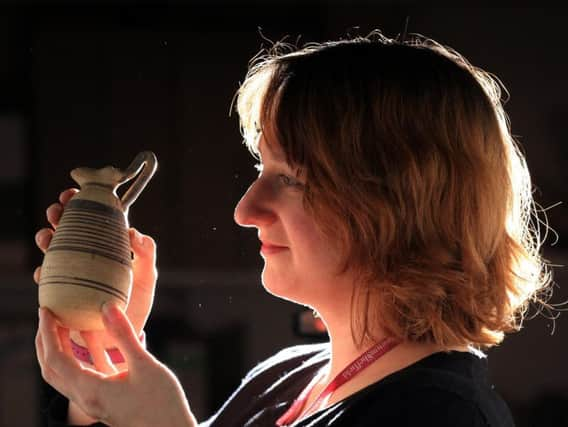Ancient fragments of Sheffield's past that tell a fascinating tale


"This is shoe leather from Sheffield Castle, mostly found in the moat," she says, holding up one of the pieces.
Martha is the curator of archaeology at Museums Sheffield, and recently a university expert was called in to the trust's store to catalogue and carefully label each swatch.
Advertisement
Hide AdAdvertisement
Hide Ad"I'm not a leather specialist, so I was able to write a label saying 'shoe sole', and that's about it. She's gone through each item and said which part of the shoe it is, and how big it is.
"Also she found lots of offcuts. So many that it's likely people were actually making shoes there and there was some kind of leather workshop. She had the idea that somebody was working, and threw the bits they didn't need into the moat. But that's moving on to interpretation."
The archaeology collection comprises around 500,000 objects spanning thousands of years. Items not on display are kept at the store, the location of which is not widely publicised for security reasons.
Last year the council announced its intention to upgrade the Graves Gallery and Central Library in the city centre, turning it into a landmark 'cultural hub’ after the idea of creating a five-star hotel at the building with Chinese investment money failed to gain momentum. In the fourth of five special features, The Star takes a look at how Museums Sheffield wants to make more of its huge archive as the gallery redevelopment plans take shape.
Advertisement
Hide AdAdvertisement
Hide AdThe core of Martha's collection is a hoard of 1,300 artefacts gathered by Thomas Batemen, a Victorian antiquarian who had his own museum, Lomberdale Hall, in Youlgreave, Derbyshire.
"He dug up - or got other people to dig up - lots of burial mounds in the Peak District, particularly Bronze Age and Anglo-Saxon ones," she says.
Some of his finds were of great significance nationally, chiefly the Benty Grange Helmet - the first Anglo-Saxon helmet to be found in Britain - which is on show at Weston Park Museum.
"We collect from the city of Sheffield and also into Derbyshire. Historically we had a wider collecting area, particularly before there were museums in places like Chesterfield or Buxton."
Advertisement
Hide AdAdvertisement
Hide AdThese days much of the material that comes in is unearthed through new developments - often part of the criteria for gaining planning permission is that an investigation is carried out; anything from a desk-based assessment to a full-scale excavation.
Sheffield Castle, for instance, will be looked at again when archaeologists move in this summer on the former Castle Market site, adding to digs conducted there in the 1920s and 50s.
"The people who will be digging there are going to be looking at those reports, building on previous knowledge."
Shelves are filled with boxes labelled with names of familiar places - for instance, one says Peace Gardens, but this could denote the nearby St Paul's offices.
Advertisement
Hide AdAdvertisement
Hide Ad"Sadly they don't assign unique names," says Martha. "Blonk Street has been re-used several times."
Rather than cherry picking individual items, 'bulk archaeology' is now the preferred policy.
"When Bateman was doing it, you picked out a few nice things and left the rest. It was good for the time, but not how you'd do it now. Now you would collect almost everything - probably not your 1970s crisp packets - but all the bits of bone and pottery, and then analyse everything. You may deposit most of it at the museum, or you may not."
The largest bulk archive is linked to Sheffield Manor, the country house built in the 16th century which now mostly lies in ruins and was excavated by museums staff from the 1960s to the 1980s.
Advertisement
Hide AdAdvertisement
Hide Ad"In the 1700s there was a pottery there that produced what's now known as Manor Ware."
Some pieces have been reconstructed with tape; last summer a research student made digital records of all the pottery pieces. "Poor man," says Martha jokingly, adding more seriously: "When we metaphorically win the lottery, that means you have money to move forward with things. You're not starting from a situation of 'We don't know how many boxes we've got'. You're building on information."
Meanwhile, the non-British collections give an insight into ancient cultures - and offer the chance to put on exhibitions of general interest that pull in visitors from further afield. Sheffield has about 1,000 Egyptian objects, and Martha has been working on a display of Cypriot artefacts.
"There is a Sheffield connection, but not a strong one, in the sense it was bought in a Sheffield auction, but at a time before the internet or public libraries. So the only way people could find out about Cyprus was through this stuff. And now we have it we're not going to get rid of it. Especially as it's really lovely, and it's been here since 1897."
Advertisement
Hide AdAdvertisement
Hide AdMartha says, musingly: "You don't really think about how significant things are. When the British Museum say 'You've got some lovely stuff', you think 'We're not just a small museum'."
Kim Streets, Museums Sheffield's chief executive, thinks the archive has unrealised potential, but accepts the complete collection could never be shown in its entirety.
"It would be great to think we could do that, but realistically to be able to display all this properly would require a museum 50 times the size of the one we've got. What I'd like to see is that this store becomes more accessible and people can see what happens behind the scenes at the museums."
